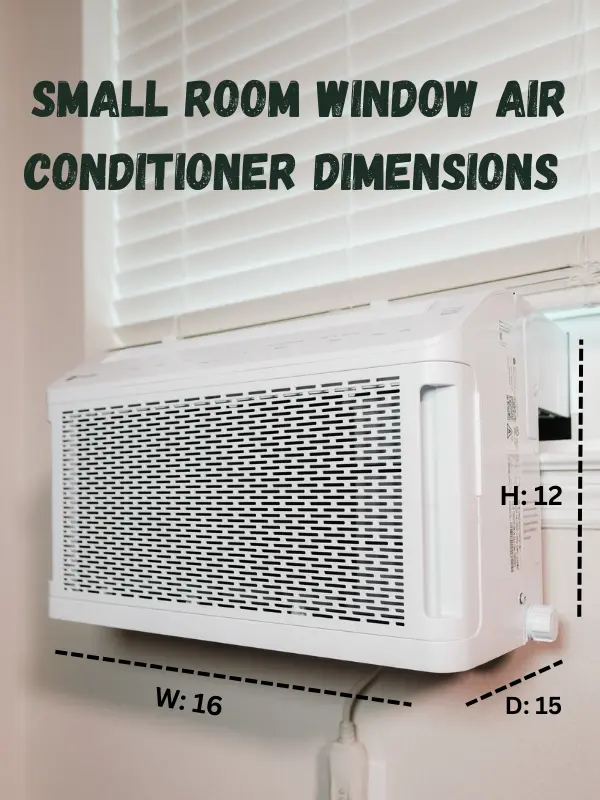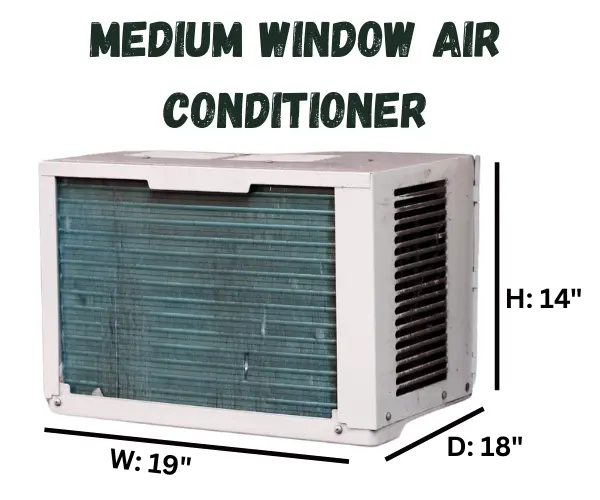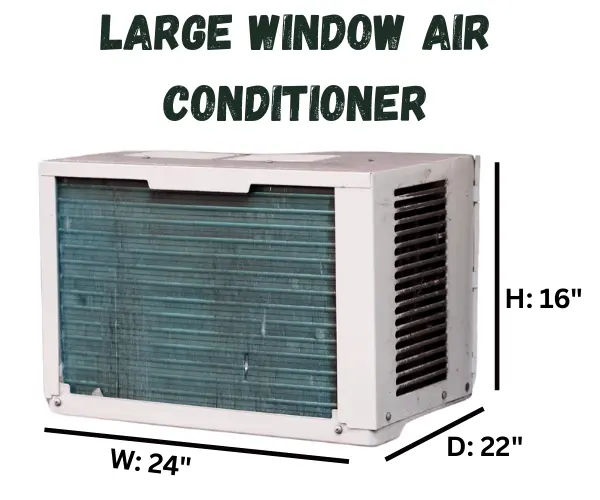Window air conditioner sizes vary by cooling capacity. Small units (5,000–8,000 BTU) are about 16–18″ wide, 12–15″ high, and 15–18″ deep. Medium units (8,000–12,000 BTU) measure 19–24″ wide, 14–18″ high, and 18–22″ deep. Large units (12,000–25,000+ BTU) range from 24–30″ wide, 16–20″ high, and 22–26″ deep. Always check exact specs before buying.
Window Air Conditioner Dimension
| BTU Range | Room Size | Dimensions (W x H x D) |
|---|---|---|
| 5,000–8,000 BTU | Small Rooms | 16–18″ x 12–15″ x 15–18″ |
| 8,000–12,000 BTU | Medium Rooms | 19–24″ x 14–18″ x 18–22″ |
| 12,000–25,000+ BTU | Large spaces | 24–30″ x 16–20″ x 22–26″ |
Why Dimensions Matter in Window AC Units
The size of your window AC unit directly affects performance, energy use, and ease of installation. While cooling power (measured in BTUs) is important, the unit’s physical dimensions determine whether it fits your window properly.
Two models with the same BTU rating can have different widths or depths, which may complicate installation. A unit that’s too large may not fit, while one that’s too small can leave gaps that cause air leaks, reduced efficiency, and higher energy bills. Improper sizing also leads to noise, poor humidity control, and strain on the unit.
For the best results, balance cooling capacity with a snug physical fit. Proper measurements ensure the unit installs securely, operates efficiently, and maintains comfort. Always check both the room size and the window size before buying to avoid unnecessary tradeoffs and installation headaches.
Common Window Air Conditioner Sizes: Finding the Right Fit
Most window AC units fall into a few standard size categories, making it easier to narrow your choices.
When it comes to sizing, window air conditioners typically fall into three categories based on cooling capacity (BTU) and physical dimensions. Understanding the tradeoffs between these sizes helps you choose the right fit for your room and window.
Small Units (5,000–6,000 BTU)
These compact units are ideal for smaller rooms (up to 150 sq. ft.). They are usually around 16 to 18 inches wide and less than 20 inches deep, making them easy to install in tight spaces. However, they may struggle in larger rooms, leading to inefficient cooling.

Medium Units (7,000–10,000 BTU)
The most versatile option, medium-sized units typically range from 18 to 24 inches in width. They fit comfortably in most windows and are effective for rooms between 150–350 sq. ft. While they strike a good balance between cooling and efficiency, choosing a unit at the top of this range could result in unnecessary power consumption for smaller rooms.

Large Units (12,000+ BTU)
These units are best for larger spaces (over 350 sq. ft.), with dimensions often exceeding 26 inches in width. They provide ample cooling but require wider or reinforced window frames for installation. Choosing an oversized unit can lead to higher energy costs and potential short cycling in smaller rooms.
Each size has its benefits and challenges. Be sure to consider room size, window dimensions, and energy efficiency when selecting the right unit. A perfect fit minimizes installation issues and helps you avoid unnecessary energy waste.

Measuring Your Window for an AC Unit
Before shopping for a unit, it’s essential to measure your window accurately. Start by measuring the width of the window opening at its narrowest point. Then, measure the height from the sill to the bottom of the top sash. Don’t forget to check the depth, especially if your unit will extend outside.
Next, consider any obstacles—such as window cranks, security bars, or screens—that might limit space. For oddly shaped or older windows, you may need custom brackets or additional sealing materials. Also, factor in allowances for mounting hardware or accordion panels, which can add several inches to the required space.
While it may seem simple, a small miscalculation can lead to poor fit, air leaks, or even the need to return the unit. Taking precise measurements upfront helps ensure the AC fits securely and performs efficiently from day one.
Depth and Clearance: Often Overlooked Dimensions
While width and height are obvious, the depth and external clearance of a window AC unit are just as critical. First, consider internal vs. external depth. Internal depth affects how much space the unit occupies inside your room, while external depth determines how far it extends outside—often up to 20 inches or more.
Next, ensure adequate clearance around the unit’s exterior. Most manufacturers recommend at least 12–24 inches of open space for proper airflow and safe heat dissipation. Ignoring this can overheat the unit and reduce efficiency.
On upper floors, clearance becomes more complex. You may need support brackets or window modifications, especially for deeper, heavier models. Though depth may seem secondary, overlooking it can lead to airflow blockages, improper draining, or safety hazards. Balancing space, performance, and safety is essential for long-term satisfaction with your AC installation.
Compact vs. Oversized Units: Pros and Cons
When it comes to air conditioner sizing, both compact and oversized units come with trade-offs. Compact units (5,000–6,000 BTU) are perfect for small rooms or windows, offering easy installation and lower energy consumption. They provide sufficient cooling for smaller spaces without taking up too much room.
However, they may struggle in larger, more open spaces or areas with poor insulation. On the other hand, oversized units (12,000+ BTU) promise powerful cooling but can be inefficient in smaller rooms. They may result in energy waste, as they cool too quickly, causing the unit to frequently cycle on and off.
Additionally, oversized units often fail to control humidity effectively, leading to uncomfortable air. Ultimately, matching the BTU rating to both your room size and window dimensions is key to maximizing efficiency and comfort.
Tips for Fitting Non-Standard Windows
If your window is unusually shaped or placed, there are still options for fitting an AC unit. To start, custom brackets or side panels can help adapt standard window ACs to non-standard frames. While they improve fit and seal, they may require extra tools and installation time.
For tall, narrow, or casement windows, consider vertical AC units designed specifically for that format. Although these models are harder to find and sometimes pricier, they offer a cleaner, safer fit with less DIY adjustment.
Alternatively, portable ACs provide flexibility. They vent through a window with a hose and can be moved as needed. However, they typically consume more floor space and may not cool as efficiently.
Each approach involves tradeoffs—between cost, convenience, and cooling performance. Choosing the right solution depends on your window’s structure, your comfort goals, and how much effort you’re willing to invest.
Conclusion
Understanding window air conditioner dimensions helps ensure your cooling solution is efficient, effective, and hassle-free. Remember to measure your window’s width, height, depth, and clearance before purchasing. A precise fit improves efficiency and comfort. For ease, use sizing charts or guides to simplify the process.
FAQs
What happens if I buy an air conditioner that’s too big for my window?
A larger unit than necessary can lead to inefficient cooling, increased energy consumption, and frequent cycling on and off. It may also result in installation challenges and unnecessary noise. Choosing the right size ensures better comfort and energy efficiency.
How do I measure my window for a window air conditioner?
To measure your window, start by measuring the width and height of the window opening. Then, check the depth to ensure the unit fits properly. Don’t forget to allow space for any mounting brackets or accordion panels. Accurate measurements are key to a good fit and efficient cooling.
Can I install a window air conditioner in a non-standard window?
Yes, you can use custom brackets or side panels for a secure fit, or choose vertical (casement) units if your window is tall and narrow. Portable ACs are another option if installing a window unit isn’t feasible. However, these alternatives may have limitations in cooling efficiency.
What is the recommended clearance for a window AC unit?
Most experts recommend 12–24 inches of external clearance for optimal airflow and heat dissipation. Insufficient clearance can result in overheating and reduced efficiency. Make sure there’s enough space around the unit for proper operation.
How do I choose the right BTU size for my room?
The ideal BTU size depends on your room’s square footage. For small rooms (100–250 sq. ft.), look for a unit with 5,000–6,000 BTUs. Medium rooms (250–450 sq. ft.) need 7,000–10,000 BTUs, and larger rooms (450 sq. ft. and beyond) may require 12,000 BTUs or more. Always balance the BTU rating with your window’s dimensions.